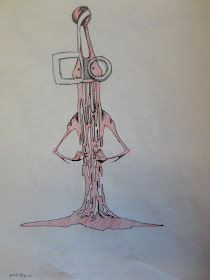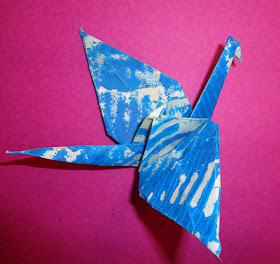This is a series done by an IB 12 student that started with a scribble and evolved into some larger pen drawings and is now evolving into large watercolour paintings.
WELCOME TO MY CLASSROOM AND THE AMAZING IMAGINATION OF THE STUDENTS AT RICHMOND HIGH SCHOOL, RICHMOND, B.C.
Thursday, 23 February 2012
IB 12 Art
This is a series done by an IB 12 student that started with a scribble and evolved into some larger pen drawings and is now evolving into large watercolour paintings.
Grade 12 IB Art
I have a grade 12 IB art student whose creative process fascinates me. Lately has been taking very large pieces of paper and crumpling them up and then throwing them on the floor. Then the inks and paints come out and before you know it they're being poured on the floor, her bare feet and hands are now multi coloured, everyone in the room has moved away from her, there's glue, glitter, fabric, magazines, found objects etc. everywhere - you get the picture - it's creative chaos. 10 minutes before the class is over she starts to clean up, washes the floor, puts away all of the materials and it's as if she was never there. After about 3 days she ends with what you see below. Difficult to capture in a photograph but hopefully you can get a sense of her end result.
Pen and Ink Doodles
This pen & ink drawing project is really doodles on steroids! I made some worksheets with various patterns for the students to work from so they could practice prior to beginning their large pen & ink doodle. Many of the students have found this type of drawing to be quite addictive. The images below are just a few that have finished a little early and I let the students choose their own subject matter - faces, initials, organic shapes, dragons, birds, butterflies etc.. A few students took the doodle project in a slightly different direction which was fine by me. The last three are by special needs students.
Tuesday, 14 February 2012
Embellished Collographs
I had the kids revisit some discarded collograph prints that they thought were absolutely hopeless. It's amazing what a little bit of chalk pastels, oil pastels, watercolours and glitter can do. There's a certain sense of freedom gained when you are allowed to just play and not worry about the end product.
Saturday, 4 February 2012
Picasso Pal - Sketchbook Exercises
The following exercises were to highlight how to document their creative process prior to beginning a project. I find that students get a little obsessed with everything in their sketchbook having to be a masterpiece, instead of a workbook that includes, writing, analysis, artist research, visual exploration, mistakes, successes etc.
Exercise #1
After students had recorded some notes on Picasso and Cubism in their sketchbook I had them draw a simple contour drawing of their running shoe on a sheet of newsprint, paying attention to detail and proportions. Despite how lovely their drawings turned out they were a little stunned when I told them to cut them up into large pieces and reassemble these pieces into a new cubist composition. This new composition was glued into their sketchbooks along side their Picasso/Cubism notes.
Exercise #2
Students then glued a magazine head into their sketchbook and then collaged facial features from other magazine heads over top. Amusing to say the least.
Exercise #3
I found this next exercise on line somewhere so thanks to whoever posted it. Without giving the students any idea where they are heading, read the following instructions out loud to them. 1. Draw an eye anywhere on your paper. 2. Turn your sketchbook 90 degrees clockwise. 3. Draw a second different eye, several times larger than the first eye. 4. Turn your sketchbook 90 degrees clockwise. 5. Draw a nose or snout. 6. Turn your sketchbook 90 degrees clockwise. 7. Draw a leg or paw. 8. Turn your sketchbook 90 degrees clockwise. Draw a tail. 9.Turn your sketchbook 90 degrees clockwise. 10. Connect the elements together with straight and curved lines. In future, I would have them at this point practice some oil pastel techniques using these drawings - light pressure, hard pressure, scraffito, blending etc..
Exercise #1
After students had recorded some notes on Picasso and Cubism in their sketchbook I had them draw a simple contour drawing of their running shoe on a sheet of newsprint, paying attention to detail and proportions. Despite how lovely their drawings turned out they were a little stunned when I told them to cut them up into large pieces and reassemble these pieces into a new cubist composition. This new composition was glued into their sketchbooks along side their Picasso/Cubism notes.
Exercise #2
Students then glued a magazine head into their sketchbook and then collaged facial features from other magazine heads over top. Amusing to say the least.
Exercise #3
I found this next exercise on line somewhere so thanks to whoever posted it. Without giving the students any idea where they are heading, read the following instructions out loud to them. 1. Draw an eye anywhere on your paper. 2. Turn your sketchbook 90 degrees clockwise. 3. Draw a second different eye, several times larger than the first eye. 4. Turn your sketchbook 90 degrees clockwise. 5. Draw a nose or snout. 6. Turn your sketchbook 90 degrees clockwise. 7. Draw a leg or paw. 8. Turn your sketchbook 90 degrees clockwise. Draw a tail. 9.Turn your sketchbook 90 degrees clockwise. 10. Connect the elements together with straight and curved lines. In future, I would have them at this point practice some oil pastel techniques using these drawings - light pressure, hard pressure, scraffito, blending etc..
Exercise #4 - Last and final sketchbook exercise!
On newsprint students prepare 3 contour drawings of their partner - front, side and 3/4 pose. Like in the shoe exercise, they cut and arrange various pieces of these three drawings into a new cubist composition and glue their final image into their sketchbook. Some of them needed to outline the main lines before they started the next step which was to enlarge this drawing onto large coloured construction before colouring with oil pastels.




























































